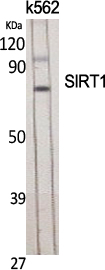
| WB | 1/500-1/1000 | Human,Mouse,Rat |
| IF | 咨询技术 | Human,Mouse,Rat |
| IHC | 1/50-1/100 | Human,Mouse,Rat |
| ICC | 1/50-1/200 | Human,Mouse,Rat |
| FCM | 咨询技术 | Human,Mouse,Rat |
| Elisa | 1/10000 | Human,Mouse,Rat |
| Aliases | SIRT1; SIR2L1; NAD-dependent protein deacetylase sirtuin-1; hSIRT1; Regulatory protein SIR2 homolog 1; SIR2-like protein 1; hSIR2 |
| Entrez GeneID | 23411 |
| WB Predicted band size | Calculated MW: 82 kDa; Observed MW: 82 kDa |
| Host/Isotype | Rabbit IgG |
| Antibody Type | Primary antibody |
| Storage | Store at 4°C short term. Aliquot and store at -20°C long term. Avoid freeze/thaw cycles. |
| Species Reactivity | Human,Mouse |
| Immunogen | The antiserum was produced against synthesized peptide derived from human SirT1. AA range:13-62 |
| Formulation | Purified antibody in PBS with 0.05% sodium azide,0.5%BSA and 50% glycerol. |
+ +
以下是关于SIRT1抗体的3篇参考文献,按作者和内容简要概括:
1. **文献名称**:*"Acetylation of the C terminus of Ku70 by CBP and PCAF controls Bax-mediated apoptosis"*
**作者**:Cohen HY, et al.
**摘要**:该研究揭示了SIRT1通过去乙酰化Ku70蛋白调控细胞凋亡的机制。文中使用SIRT1抗体进行免疫沉淀和Western blot分析,验证了SIRT1与Ku70的相互作用及其在抑制Bax介导的凋亡中的功能。
2. **文献名称**:*"SIRT1 regulates insulin secretion by repressing UCP2 in pancreatic β cells"*
**作者**:Bordone L, et al.
**摘要**:文章探讨了SIRT1在胰岛β细胞中通过抑制UCP2表达调控胰岛素分泌的作用。研究通过SIRT1特异性抗体进行免疫组织化学和ChIP实验,证实SIRT1直接结合UCP2启动子并影响其活性。
3. **文献名称**:*"Nutrient-sensitive mitochondrial NAD+ levels dictate cell survival"*
**作者**:Yang T, et al.
**摘要**:该研究阐明了SIRT1依赖的线粒体NAD+水平对细胞存活的调控。利用SIRT1抗体进行免疫荧光和Western blot,作者发现SIRT1在能量限制条件下通过去乙酰化作用增强线粒体功能,从而抑制细胞凋亡。
---
**备注**:上述文献均涉及SIRT1抗体的实验应用(如Western blot、免疫沉淀、免疫组化等),并聚焦于SIRT1在代谢、凋亡或疾病中的分子机制。建议通过PubMed或Google Scholar检索具体文献以获取全文细节。
SIRT1 (silent mating type information regulation 2 homolog 1) is a NAD⁺-dependent deacetylase belonging to the sirtuin family, known for its critical roles in regulating cellular processes such as metabolism, stress response, aging, and gene silencing. It modulates the activity of diverse substrates, including histones, transcription factors (e.g., p53. NF-κB), and metabolic enzymes, through post-translational deacetylation. SIRT1's involvement in lifespan extension, calorie restriction benefits, and diseases like diabetes, neurodegeneration, and cancer has made it a key focus in biomedical research.
Antibodies against SIRT1 are essential tools for detecting its expression, localization, and interactions in cells and tissues. They are widely used in techniques such as Western blotting, immunohistochemistry (IHC), immunofluorescence (IF), and chromatin immunoprecipitation (ChIP). However, SIRT1 antibodies require rigorous validation due to potential cross-reactivity with other sirtuin family members (e.g., SIRT2 or SIRT3) or nonspecific binding. Researchers must select antibodies based on species reactivity, clonality (polyclonal vs. monoclonal), and application-specific performance. Some antibodies target specific regions, such as the N-terminal or catalytic domain, which may influence detection under different experimental conditions (e.g., post-translational modifications). Commercial SIRT1 antibodies are available from multiple suppliers, often accompanied by validation data in knockout models or siRNA-treated samples to confirm specificity. Proper controls, including knockout/knockdown validation and peptide blocking, are critical to ensure reliable results in SIRT1-related studies.
×